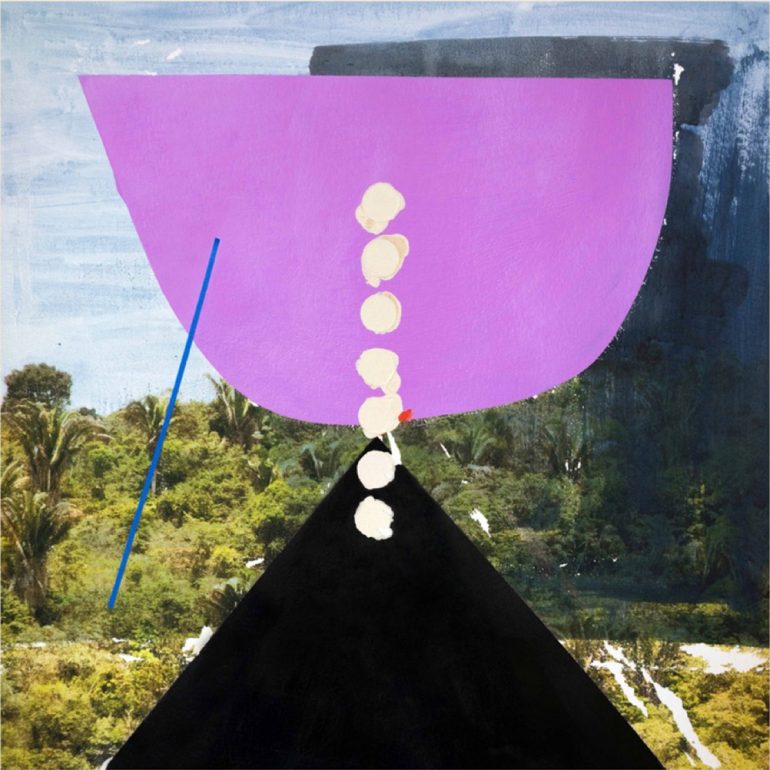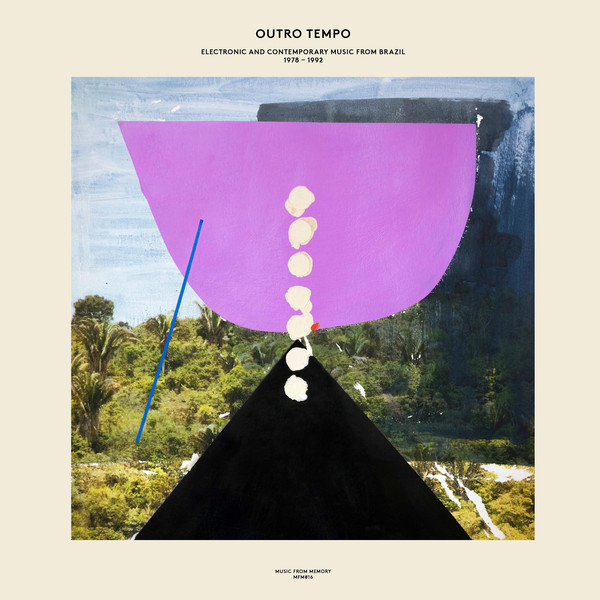“I’m most excited by music that doesn’t feel like it belongs anywhere, that sits between genres, places, and times” – John Gómez
When talking about DJ and record collector, John Gómez, in-betweenness is an often recurring concept – on a personal, as well as a professional level. When asked about this in-betweenness by Stamp the Wax, he declares that “That’s when I find music most exciting”[…] “When music sits between genres, in a way it reflects my own identity, being between Spanish and English; there’s this space in-between, which I find most interesting””.
Although born in Madrid, Gómez has been moving back and forth between Spain and his current home, the UK, from a young age. How fitting it is then, that on his first album, he applies a similar philosophy on the selected music, combining musical material that in itself sits in-between spaces, expresses a longing for different places, and bears the title Outro Tempo – another time.
Outro Tempo is a collection of Brazilian music, all released within the period between 1978 and 1992, as indicated by the record’s subtitle. Even if you consider yourself familiar in the world of Brazilian music beyond the usual suspects, this record will still definitely surprise you.
Another time and space
In the liner notes, the selector himself recalls a conversation with Priscilla Ermel, one of the featured artists on the album, where she refers to the time when she created her music, operating at a different tempo. Pondering on what this means Gómez writes:
“The music brought together in this compilation is one that shape shifts. It feels, at once, perfectly of its moment and entirely removed from it. This is, perhaps, the outro tempo that Ermel referred to: a moment in Brazilian consciousness that responded to the country’s circumstances and integrated its heritage, but which also reached out to something just beyond its borders, beyond the contemporary, beyond that time.”
Most of the music of Outro Tempo is made during or just after the final years of the military dictatorship in Brazil, ranging from 1964 to 1985. As music in Brazil is closely associated with national identity, on Outro Tempo it serves as an important role in creating a space in-between, where oppositions are combined and mixed into an entirely new universe. (For more on Brazilian identity and in-between spaces, see The space in-between, by Silviano Santiago; a collection of essays written – interestingly – in the period between 1969 and 1995.)
The political opening of the regime and increasing globalization in the beginning of the eighties proposed a tension clearly audible on the record. On the one hand, there was a renewed interest for local and regional culture, almost towards national exoticism. On the other hand, it was suddenly possible to import new technology, generating experiments with new electronic musical instruments and recording techniques.
The tension between local and global fascinations is apparent in the fourth track on the album: Só quero um xodó, by Os Mulheres Negras, with the main elements being a synthetic electronic beat and synths, but lyrics and melody still similar to the original Northeastern song. And for a little transnationalism, the “women” also throw in an Indian sitar, with its droney sound almost reminiscent of an accordion on LSD – accordion being one of the key instruments in regional Northeastern musical styles as baião.
The northeastern influence doesn’t come from far: Só quero um xodo is originally written by Gilberto Gil in 1973, together with accordion player Dominhuinhos. Gil recorded the song just after returning from his time in London, as he was exiled by the aforementioned military regime.
O Nordeste, the Brazilian northeast, is not the only region that serves as a source of national exotic inspiration. To return to Brazil’s roots, many musicians explore the music of its original inhabitants: indigenous tribes.
Indigenous inspiration
On Outro Tempo, the Amazon rain forest is referred to in different ways – sometimes just in a title that references tribe names, sometimes in the selection of used instruments, such as flute, mouth harp or shakers.
Some artists, however, got more than superficially involved with indigenous music and culture. Priscilla Ermel studied Tupi culture extensively as an ethnomusicologist, which she also documents in videos.
Amid many of the interrelated musicians, is the figure of Egberto Gismonti. Although Outro Tempo doesn’t feature any songs of Gismonti directly, he seems to be omnipresent in the background, sometimes as a collaborating artist, sometimes in the form of his label Carmo, that produces some of the albums featured on Outro Tempo. Like Ermel, Gismonti also visits indigenous territory, Alto do Xingu in his case, in 1977, taking a lot of inspiration from the people he met and bringing it into his own artistry. Directly after his stay, he recorded the album Sol do Meio Dia, and named one of the songs after the tribe’s shaman, Sapain.
The time of the instrumentalists
Until the end of the seventies, Brazil had rigid censorship on all cultural expressions, in the form of Ato Institucional 5. This act ended in 1978, and opened up space for new experimentation, also audible on Outro Tempo. Many of the songs mix the regional inspiration described above with foreign sounds and styles. Experimental and new instrumental music gains more and more popularity:
“A new generation of instrumentalists, who called their music música instrumental brasileira contemporânea (contemporary Brazilian instrumental music), began garnering media attention in the mid-1970s. The new instrumental music reflected itself in the eclectic influences of MPB, a cosmopolitan stew of national and international musics, drawing especially from north eastern rhythms. While jazz remained a strong inspiration, many musicians also cited European progressive rock bands … This was also the case for fans of the new music, as saxophonist/flutist Mauro Senise noticed. “These days, at an Egberto [Gismonti] show – which is a pure sound – you encounter all [these] young rock fans (music journalist Ana Maria Baiana in O Almanaque dos 70, 1979).
With the renewed interest for foreign music styles, also came an interest in new music technology. This new technology made it possible for many artists to become independent from the dominant music industry and its rules. As a result, musicians started to record, produce and distribute records themselves. One of the first examples that paved the way for an independent record industry is a record by Antonio Adolfo in 1977, called Feito em Casa (Home made) – Adolfo stamped all of his records himself, creating a unique sleeve for each.

Antonio is not the only one: some of the artists on Outro Tempo, such as Marco Bosco and Maria Rita, also produced their albums independently:
“Back in Brazil in 1981, Marco Bosco had effective participation in the beginning of the Brazilian independent phonographic production, occasion in which he independently produced, recorded and distributed “Aqualouco” (Café/FIF), the second album of the Grupo Acaru”. (Biography Marco Bosco on CD Baby)
The longing for independence comes from an increasing discontentment among instrumental musicians about the Brazilian record industry:
“In the article titled “O tempo das instrumentalistas [The time of the Instrumentalists]”, journalist Paulo Venancio argued that instrumental music musicians had long been marginalized within the “discourse” of MPB, kept under the thumb, so to speak of vocal music. Despite the contributions that instrumentalists had made to the success of certain popular stars, rarely were their names mentioned or even printed on the record jackets.”” (Andrew Connell in his doctoral dissertation Jazz Brasileiro? Música Instrumental Brasileira and the Representation of Identity. 2002)
The undervalued role of many instrumental musicians might also explain the unknown character of many of the songs on Gómez’ compilation, or among some musicians even some hesitation about the quality of their work back in the days. As Gómez describes in an interview: “Many of these artists simply hadn’t seen their work within the context of this political period before, or at least, hadn’t seen it with such clarity.” (on Stamp the Wax)
However, bringing all these seemingly different songs together on one record, makes it clear that neither the music, nor its musicians, belong somewhere in-between places. Through extensive research and a keen eye and ear for the cultural context of the music and the people that made it, Gómez connects different dots and brings them all to the centre. I can only look forward to what the next compilation will be.
Written by Anneke Van Woerden


